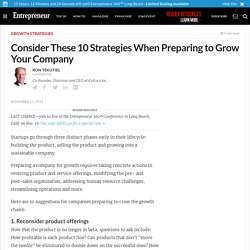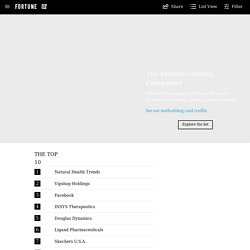

Consider These 10 Strategies When Preparing to Grow Your Company. Startups go through three distinct phases early in their lifecycle: building the product, selling the product and growing into a sustainable company.

Preparing a company for growth requires taking concrete actions in evolving product and service offerings, modifying the pre- and post-sales organization, addressing human resource challenges, streamlining operations and more. Here are 10 suggestions for companies preparing to cross the growth chasm: 1. Reconsider product offerings Now that the product is no longer in beta, questions to ask include: How profitable is each product line? Related: Before You Decide to Scale Your Business, Answer These 4 Questions Challenge conventions and consider new blue-ocean opportunities, including ones that would require a mergers and acquisitions to fulfill. 2. As sales ramp up, there will be a diminishing productivity rate, largely because the salesforce is no longer only comprised of the passionate founder. Growth Isn't Everything: 7 Lessons Learned from 5 Failed Companies.
So you want to grow your business.

I get that. You probably wouldn’t be here if expansion wasn’t on your mind. But while strategies to help you increase your customer base and boost revenue are – on the surface – a good thing, growth alone isn’t enough to support and sustain a company if the right conditions aren’t met. Unfortunately, it’s not uncommon for businesses that excited about growth to accept – or even create – challenges that they’re not equipped to handle. This might mean: The results, in most cases, are cash flow shortages and/or long-term damage to your brand and customer relations. Is any of this sounding familiar? Crumbs Bake Shop Crumbs Bake Shop launched in 2003. Just three years later, in June of 2014, Crumbs’ share price had fallen to a paltry $0.15. One key factor in both Crumbs’ success and their subsequent fall from glory was their short-sighted focus on a single, trending product: cupcakes.
This is the Google Trends data for cupcakes for the last ten years: Zynga. Fortune's 100 Fastest-Growing Companies. To qualify, a company—domestic or foreign—must be trading on a major U.S. stock exchange; report data in U.S. dollars; file quarterly reports with the SEC; have a minimum market capitalization of $250 million and a stock price of at least $5 on June 30, 2016; and have been trading continuously since June 30, 2013.

Companies must have revenue and net income for the four quarters ended on or before April 30, 2016, of at least $50 million and $10 million, respectively; and have posted an annualized growth in revenue and earnings per share of at least 15% annually over the three years ended on or before April 30, 2016. Companies that meet these criteria are ranked by revenue growth rate; EPS growth rate; and three-year annualized total return for the period ended June 30, 2016. (To compute the revenue and EPS growth rates, Fortune uses a trailing-four-quarters log linear least square regression fit.) The overall rank is based on the sum of the three ranks. IN GOOD COMPANY: 10 common challenges in growing any business – and how to tackle them.
The In Good Company series gives you an inside look into how leading Australian businesses have achieved success.

At Bankwest, we believe that good relationships lead to great businesses. Watch our client success stories at bankwest.com.au/ingoodcompany. Expansion is the sign of a healthy business. Employing more staff, growing profit, building your industry reputation – these are all exciting developments that come with growth but they can also present new challenges.
For one, a larger headcount can require more office space, salary packages and HR policies to oversee the staffers needs and safety. With this is mind, Business Insider has pulled together a list of common challenges any growing business can face, and solutions for how to tackle them. 1. When your company is growing, workloads can intensify quickly. For companies such as Apple this all starts with the hiring of management. “Ultimately, it’s on the company leaders to set the tone,” Cook told Fast Company.